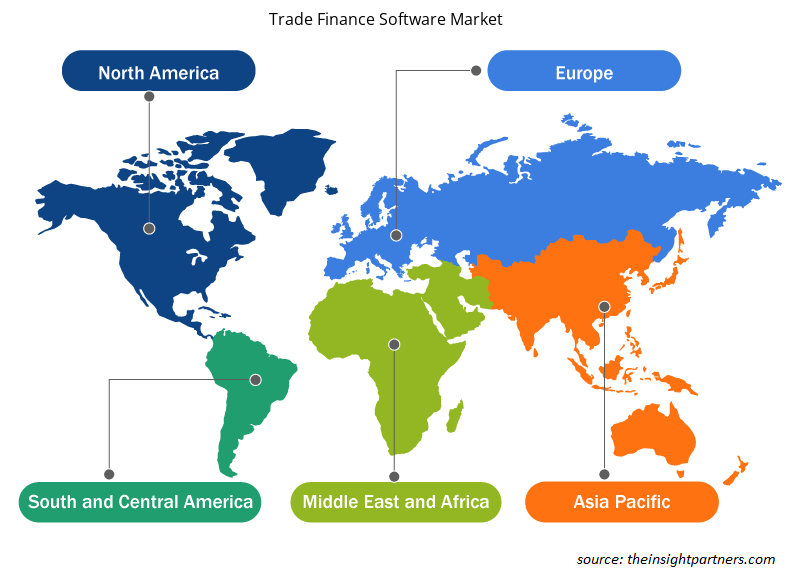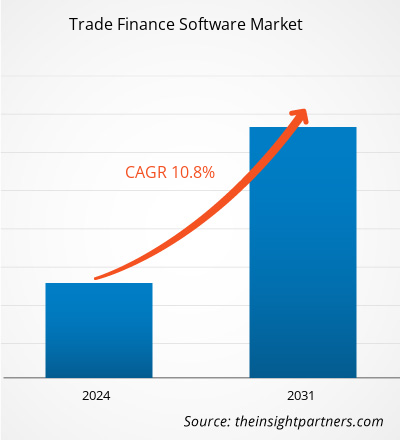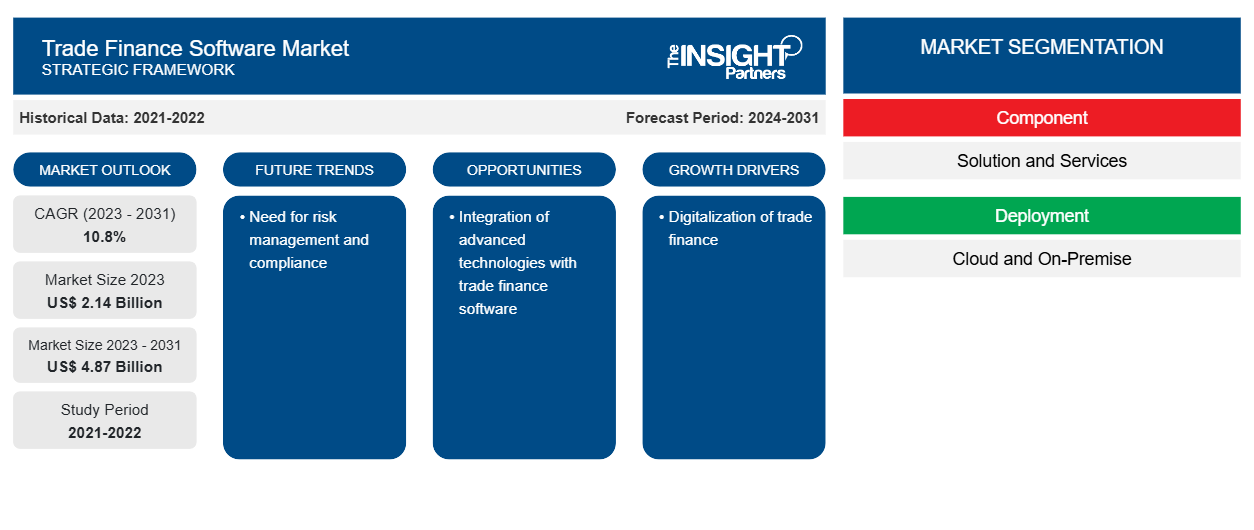무역 금융 소프트웨어 시장 규모는 2023년 21억 4천만 달러에서 2031년 48억 7천만 달러로 성장할 것으로 예상됩니다. 이 시장은 2023~2031년에 10.8%의 CAGR을 기록할 것으로 예상됩니다. 디지털화와 클라우드 기반 기술의 도입이 무역 금융 소프트웨어 시장의 주요 트렌드로 남을 가능성이 높습니다.
무역 금융 소프트웨어 시장 분석
무역 금융 프로세스의 디지털화 증가는 무역 금융 소프트웨어 시장 성장을 촉진하는 주요 요인입니다. 효율성이 높아지고 비용이 낮아지면서 전자 문서와 클라우드 기반 무역 금융 솔루션이 점차 전통적인 종이 기반 방법을 대체하여 시장 성장에 기여하고 있습니다.
무역 금융 소프트웨어 시장 개요
투명성과 국제 무역 규정 준수에 대한 필요성은 실시간 모니터링 및 보고 기능이 있는 소프트웨어 솔루션의 채택을 촉진했습니다. 국제 무역의 변화하는 요구를 충족하는 최첨단 솔루션을 제공하는 데 중점을 두고, 무역 금융 소프트웨어 시장은 글로벌 무역 환경이 계속 변화하고 기업이 보다 안전하고 효율적인 무역 금융 운영을 추구함에 따라 더욱 확장될 준비가 되었습니다.
귀하의 요구 사항에 맞게 이 보고서를 사용자 정의하세요
이 보고서의 일부 또는 국가 수준 분석, Excel 데이터 팩을 포함하여 모든 보고서에 대한 사용자 정의를 무료로 받을 수 있으며 신생 기업 및 대학을 위한 훌륭한 혜택과 할인 혜택을 이용할 수 있습니다.
-
이 보고서의 주요 시장 동향을 알아보세요.이 무료 샘플에는 시장 동향부터 추정 및 예측까지 다양한 데이터 분석이 포함됩니다.
무역 금융 소프트웨어 시장 동인 및 기회
무역금융의 디지털화로 시장 활성화
다양한 산업의 기업들이 국제 무역 운영을 신속히 처리하고 개선하기 위해 최첨단 솔루션이 필요하다는 것을 깨닫고 시장이 크게 확대되고 있습니다. 이 시장에는 공급망 금융, 규정 준수 관리, 송장 팩토링, 신용 관리와 같은 무역 금융 절차를 개선하고 자동화하도록 만들어진 소프트웨어 프로그램이 포함됩니다. 조직은 무역 거래의 복잡성과 양이 증가함에 따라 수동적이고 시간 소모적인 작업을 줄이고 정확성을 높이며 국제 무역과 관련된 위험을 최소화하기 위해 무역 금융 소프트웨어를 사용하게 되었고, 이는 시장 참여자들의 무역 금융 소프트웨어 도입으로 이어졌습니다. 예를 들어, 2023년 11월, 금융 소프트웨어 애플리케이션 및 마켓플레이스의 글로벌 공급업체인 Finastra는 국제 기업 은행인 CQUR Bank가 Finastra와 협력하여 기술 전략을 실현했다고 발표했습니다. Finastra의 시장 선도적 솔루션인 Trade Innovation 및 Corporate Channels를 구현하여 CQUR Bank는 기업 고객에게 원활한 사용자 경험을 위한 새로운 온라인 뱅킹 포털을 제공하고, 새로운 디지털 워크플로를 도입했으며, 호스트 간 통합 솔루션을 제공합니다.
위험 관리 및 규정 준수의 필요성
개선된 위험 관리 및 규정 준수에 대한 필요성이 커지면서 무역 금융 소프트웨어 시장이 성장하는 또 다른 요인이 되었습니다. 무역 금융 소프트웨어는 사기 탐지, 자금 세탁 방지 (AML) 검사, 무역법 및 제재 준수와 같은 정교한 도구를 제공하여 국제 무역과 관련된 위험을 추적하고 감소시킵니다. 기업과 금융 기관이 법률 및 규정 준수를 유지하면서 국제 무역의 과제를 관리하려고 하면서 이러한 소프트웨어 솔루션에 대한 필요성이 계속 커지고 있습니다.
무역 금융 소프트웨어 시장 보고서 세분화 분석
무역 금융 소프트웨어 시장 분석에서 중요한 요소는 구성 요소, 배포, 기업 규모, 최종 사용입니다.
- 구성 요소를 기준으로 시장은 솔루션과 서비스로 세분화됩니다. 솔루션 세그먼트는 2023년에 더 큰 시장 점유율을 차지했습니다.
- 배포에 따라 시장은 클라우드와 온프레미스로 세분화됩니다. 클라우드 세그먼트는 2023년에 더 큰 시장 점유율을 차지했습니다.
- 기업 규모에 따라 시장은 대기업과 중소기업으로 세분화됩니다. 중소기업 부문은 가장 높은 CAGR로 성장할 것으로 예상됩니다.
- 최종 사용에 따라 시장은 은행, 거래자 및 기타로 세분화됩니다. 은행 부문은 2023년에 더 큰 시장 점유율을 차지했습니다.
지역별 무역 금융 소프트웨어 시장 점유율 분석
무역 금융 소프트웨어 시장 보고서의 지리적 범위는 주로 북미, 아시아 태평양, 유럽, 중동 및 아프리카, 남미/남중미의 5개 지역으로 나뉩니다.
수익 측면에서 북미는 2023년 가장 큰 무역 금융 소프트웨어 시장 점유율을 차지했습니다. 북미는 기술 솔루션을 일찍 도입하여 시장 점유율이 급증했습니다. 중소기업이 클라우드 기반 기술을 도입하면서 시장이 성장했습니다. 은행의 급증하는 디지털화는 무역 금융 소프트웨어에 대한 수요를 더욱 증가시켜 북미 무역 금융 시장 점유율을 끌어올렸습니다.
무역 금융 소프트웨어 시장 지역 통찰력
Insight Partners의 분석가들은 예측 기간 동안 무역 금융 소프트웨어 시장에 영향을 미치는 지역적 추세와 요인을 철저히 설명했습니다. 이 섹션에서는 북미, 유럽, 아시아 태평양, 중동 및 아프리카, 남미 및 중미의 무역 금융 소프트웨어 시장 세그먼트와 지리에 대해서도 설명합니다.

- 무역 금융 소프트웨어 시장에 대한 지역별 특정 데이터 얻기
무역 금융 소프트웨어 시장 보고서 범위
| 보고서 속성 | 세부 |
|---|---|
| 2023년 시장 규모 | 21억 4천만 달러 |
| 2031년까지 시장 규모 | 48억 7천만 달러 |
| 글로벌 CAGR (2023-2031) | 10.8% |
| 역사적 데이터 | 2021-2022 |
| 예측 기간 | 2024-2031 |
| 다루는 세그먼트 |
구성 요소별로
|
| 포함된 지역 및 국가 |
북아메리카
|
| 시장 선도 기업 및 주요 회사 프로필 |
|
무역 금융 소프트웨어 시장 참여자 밀도: 비즈니스 역학에 미치는 영향 이해
무역 금융 소프트웨어 시장은 소비자 선호도의 변화, 기술 발전, 제품의 이점에 대한 인식 증가와 같은 요인으로 인해 최종 사용자 수요가 증가함에 따라 빠르게 성장하고 있습니다. 수요가 증가함에 따라 기업은 제품을 확장하고, 소비자의 요구를 충족하기 위해 혁신하고, 새로운 트렌드를 활용하여 시장 성장을 더욱 촉진하고 있습니다.
시장 참여자 밀도는 특정 시장이나 산업 내에서 운영되는 회사나 기업의 분포를 말합니다. 주어진 시장 공간에 얼마나 많은 경쟁자(시장 참여자)가 존재하는지 그 규모나 전체 시장 가치에 비해 나타냅니다.
무역 금융 소프트웨어 시장에서 운영되는 주요 회사는 다음과 같습니다.
- 주식회사 씨지아이
- 코마르크 SA
- IBSFINtech
- ICS 금융 시스템 유한회사
- MITech - 직관적인 기술 SA 만들기
- 뉴젠 소프트웨어 테크놀로지스(주)
면책 조항 : 위에 나열된 회사는 어떤 특별한 순서에 따라 순위가 매겨지지 않았습니다.

- 무역 금융 소프트웨어 시장 주요 주요 업체 개요를 알아보세요
무역 금융 소프트웨어 시장 뉴스 및 최근 개발
무역 금융 소프트웨어 시장은 1차 및 2차 조사 이후의 질적, 양적 데이터를 수집하여 평가합니다. 여기에는 중요한 기업 간행물, 협회 데이터 및 데이터베이스가 포함됩니다. 다음은 시장의 개발 목록입니다.
- 2022년 9월, 디지털 혁신 제품의 선도적인 글로벌 공급업체인 Newgen Software가 뭄바이에서 열린 고객 미팅에서 세계 최초의 로우코드 무역 금융 플랫폼을 출시했습니다. 무역 금융은 많은 서류 작업, 여러 이해 관계자 및 규정 준수 요구 사항이 포함되기 때문에 복잡한 프로세스입니다. Newgen의 포괄적이고 구성 가능하며 미래에 대비한 무역 금융 플랫폼은 은행이 서류 없이 거래 프로세스를 간소화하고 국내 및 국제 규정을 준수하도록 돕습니다. (출처: CXOtoday, 보도자료, 2022)
- 2024년 2월, 금융 소프트웨어 애플리케이션 및 마켓플레이스의 글로벌 공급업체인 Finastra와 글로벌 디지털 혁신 컨설팅 및 통합업체인 Tesselate는 더 빠르고 쉬운 무역 금융 디지털화를 위한 엔드투엔드 사전 패키지 서비스 출시를 발표했습니다. Finastra Trade Innovation 및 Corporate Channels에서 지원하는 Tegula Trade Finance as a Service를 사용하면 미국 은행이 수동 프로세스를 자동화하고 더 빠른 출시 시간과 가치로 새로운 수요에 적응할 수 있습니다. Finastra의 FusionFabric.cloud를 통해 은행은 인공 지능, 블록체인 및 자동화 도구와 같은 최신 기술을 사용하는 핀테크 애플리케이션을 원활하게 통합할 수도 있습니다. (출처: Finastra, 보도자료, 2024)
무역 금융 소프트웨어 시장 보고서 범위 및 제공물
"무역 금융 소프트웨어 시장 규모 및 예측(2021-2031)" 보고서는 아래 영역을 포괄하는 시장에 대한 자세한 분석을 제공합니다.
- 범위에 포함된 모든 주요 시장 세그먼트에 대한 글로벌, 지역 및 국가 수준의 시장 규모 및 예측
- 동인, 제약 및 주요 기회와 같은 시장 역학
- 주요 미래 트렌드
- 자세한 PEST/포터의 5가지 힘과 SWOT 분석
- 주요 시장 동향, 주요 업체, 규정 및 최근 시장 동향을 포괄하는 글로벌 및 지역 시장 분석
- 시장 집중도, 히트맵 분석, 유명 기업 및 최근 개발 사항을 포함하는 산업 환경 및 경쟁 분석
- 자세한 회사 프로필
- 과거 분석(2년), 기준 연도, CAGR을 포함한 예측(7년)
- PEST 및 SWOT 분석
- 시장 규모 가치/거래량 - 글로벌, 지역, 국가
- 산업 및 경쟁 환경
- Excel 데이터세트
최근 보고서
관련 보고서
사용 후기
구매 이유
- 정보에 기반한 의사 결정
- 시장 역학 이해
- 경쟁 분석
- 고객 인사이트
- 시장 예측
- 위험 완화
- 전략 기획
- 투자 타당성 분석
- 신흥 시장 파악
- 마케팅 전략 강화
- 운영 효율성 향상
- 규제 동향에 발맞춰 대응























 무료 샘플 받기 - 무역 금융 소프트웨어 시장
무료 샘플 받기 - 무역 금융 소프트웨어 시장